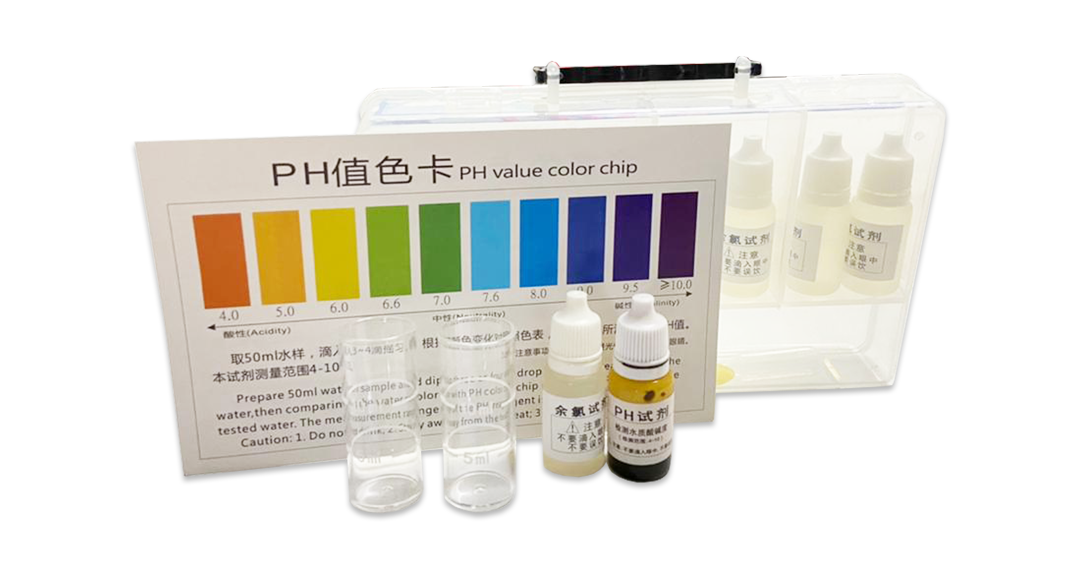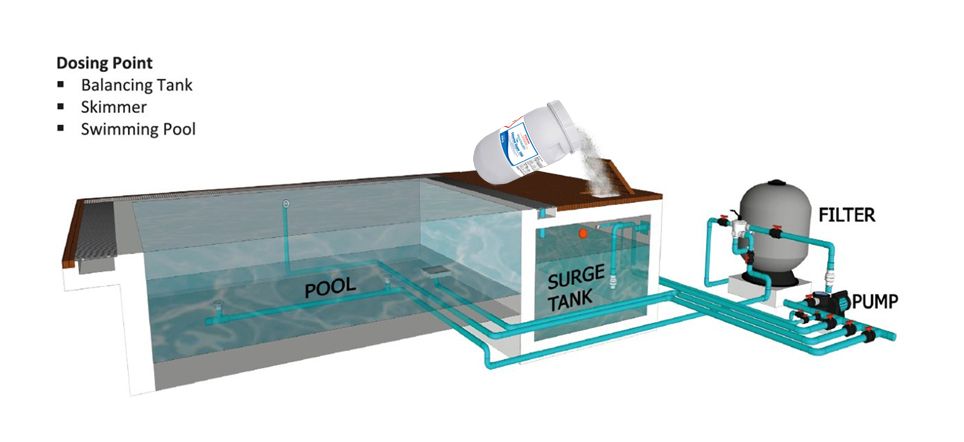POOL MAINTENANCE KITS
What is the optimal chlorine level for swimming pool ?
Chlorine helps protect swimmers from waterborne germs. Therefore, it is important
that pool owners and caretakers to consider the right amount of chlorine put into
the water.
Sometimes, too much chlorine can cause red eyes or irritation to the skin, too little
amount offers insufficient level of protection against germs in the water.
Then, how can we get it right ? We have the answer for you.

Standard chlorine (CL) value in swimming pools :
- For residential pools : 1 - 2 PPM
- For commercial pools : 2 - 3 PPM
Standard pH in the pool :
- The optimum pH for swimming pool is 7.4 (or between 7.2 – 7.6).
- if the pH is below 7 the water is acid
- If the pH is above 7, the water is alkaline
Adding Chlorine into your pool

Chlorine
Chlorine is one of the most commonly used disinfectants for water disinfection and easily available from the marketplace.
It comes in three forms which liquid, granular and tablet. Each varying in strength and efficiency when placed under direct
sunlight. Chlorine can be applied for the deactivation of most microorganisms and it is relatively cheap. It has been used
for applications, such as the deactivation of pathogens in drinking water, swimming pool water and wastewater, for the
disinfection of household areas and for textile bleaching.
Chlorine is quickly consumed because the following factors are commonly found present in the water :
- Presence of Bacteria
- Presence of Algae Organic matter such as leaves, twigs, grass
- Organic by-products such as human or animal sweat and waste
- Sunlight
- Increase water temperature and evaporation
- Mechanical energy from moving water such as fountains and water features
Application :
- Swimming pool / Spa
- Raw Water / underground water / Drinking Water
- Agriculture / Aquaculture
- Industry Water treatment
Standard Dosing Formula for CL Level
| CL Type | Volume (g) | Capacity (m3) | CL Value (ppm) | |
| C70 | 1.43g | 1 m3 | +1 ppm | |
| S700 | 1.43g | 1 m3 | +1 ppm |
| CL Type | Volume (g) | Capacity (m3) | CL Value (ppm) | |
| T99 | 200g | 18 m3 | +0.5 - 1 ppm | |
| C99 | 200g | 18 m3 | +0.5 - 1 ppm |
*** The product safety : this product is non-reactive & stable under normal conditions of storage & use. May intensify fire, keep away
from heat, hot surfaces, sparks, open flames and other ignition sources. No Smoking. Contact with acid liberates toxic gas.
Adjusting pH values for the pool :
The standard pH for a common pool should be pH = 7.4 or between 7.2 -7.6.
- pH lower than 7.2 (acidic) will cause chlorine to dissolve rapidly and cause irritation to the eyes, especially in chlorinated pools. (TCCNA90)
- Solution: Use 1 kilogram of soda ash per 100 cubic meters of water in the pool (depending on
acidity level. If the water is very acidic, such as pH 6.0 – 6.8, more soda ash must be added.)
- pH higher than 7.6 (alkaline) will result in poorer chlorine performance, causing sediment, water
turbidity and eye irritation, especially in salt-water pools.
- Solution: Use 1 liter of hydrochloric acid (HCl) or (NaHSO4) per 100 cubic meters of water in
the pool (depending on the level of alkalinity. If the water is very alkaline, such as pH 7.6 – 8.0,
more amount of hydrochloric acid must be used.)
Potential of Hydrogen
A measure of Acidity & Alkalinity of a solution :

Standard Dosing Formula for pH Level
| pH Type | Volume (g) | Capacity (m3) | pH Value | |
| A90 | 2g | 1 m3 | +0.1 |
APPLICATION
Chlorine is one of the most commonly used disinfectants for water disinfection and easily available from the marketplace.
It comes in three forms which liquid, granular and tablet. Each varying in strength and efficiency when placed under direct
sunlight. Chlorine can be applied for the deactivation of most microorganisms and it is relatively cheap. It has been used
for applications, such as the deactivation of pathogens in drinking water, swimming pool water and wastewater, for the
disinfection of household areas and for textile bleaching.